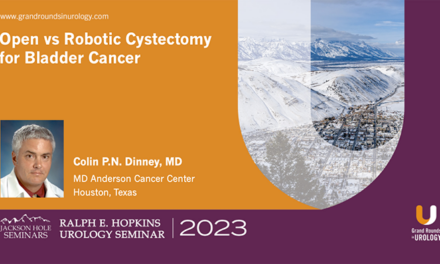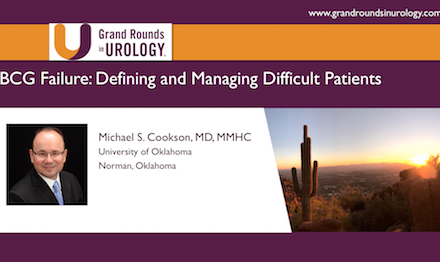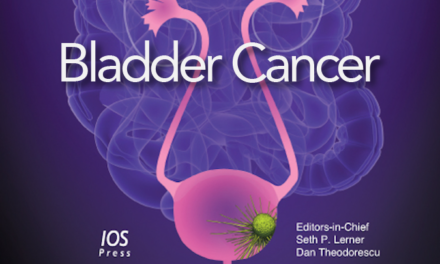Amirali Salmasi, MD, presented “Updating the Definitions, Endpoints, and Clinical Trial Designs for Bladder Cancer” during the 29th Annual Perspectives in Urology: Point-Counterpoint, on November 18, 2021, in Coronado Island, San Diego, California.
How to cite: Salmasi, Amirali. “Updating the Definitions, Endpoints, and Clinical Trial Designs for Bladder Cancer.” November 18, 2021. Accessed Nov 2025. https://grandroundsinurology.com/updating-the-definitions-endpoints-and-clinical-trial-designs-for-bladder-cancer/
Updating the Definitions, Endpoints, and Clinical Trial Designs for Bladder Cancer
Amirali Salmasi, MD, Assistant Professor of Urology at the University of California, San Diego, reviews risk stratification guidelines for non-muscle invasive bladder cancer (NMIBC) from the American Urological Association (AUA) and European Association of Urology (EAU); pointing out that the AUA classifies solitary high-grade (HG) Ta lesions ≤3cm classified as intermediate risk (IR-Ta) while the EAU recommends all HG tumors be classified as high-risk. Dr. Salmasi then presents data suggesting that, indeed, all HG Ta lesions should be considered high risk, supporting the EAU risk stratification model. He then reviews recommendations from the International Bladder Cancer Group, including definitions, end points, and clinical trial designs for NMIBC for both BCG-naive and BCG-unresponsive patients. For BCG-naive patients, Dr. Salmasi defines the clinically significant outcome of an absolute difference of 10 percent in the percentage of patients with recurrence at two years. For BCG-unresponsive patients with carcinoma in situ (CIS), a clinically meaningful magnitude of effect is an initial complete response rate of 50 percent at six months and a durable response rate of 30 percent at 12 months and 25 percent at 18 months; for those with papillary disease, it is a recurrence-free rate of 30 percent at 12 months and 25 percent at 18 months. Dr. Salmasi then shares information refining neoadjuvant therapy clinical trial design for muscle-invasive bladder cancer (MIBC) before cystectomy, citing level-one evidence that says neoadjuvant chemotherapy (NAC) should be offered to any “fit” patient before radical cystectomy (RC). He discusses eligibility and staging before discussing treatment options, posing questions about appropriate control arms for neoadjuvant trials as well as what number of neoadjuvant therapy cycles might be ideal, acknowledging that the best combination of treatment options remains uncertain. Dr. Salmasi discusses primary endpoints for neoadjuvant trials before shifting to a discussion on the future of trial design. He outlines some potential improvements to trial design, including sample size re-estimation; adaptive enrichment; seamless design; multi-arm, multistage (MAMS) trials; and biomarker-based adaptive study. Dr. Salmasi then outlines the benefits and limitations of MAMS trials and describes the characteristics of umbrella trials and basket trials. He discusses the BISCAY flowchart and the trial’s limitations and discusses the future of biomarker-based trial design in bladder cancer, citing two successful, meaningful biomarker-adaptive trials (PROOF 302 and IMvigor 011). Dr. Salmasi concludes by outlining future directions in the field, including ongoing trials for treatments for BCG-unresponsive NMIBC as well as neoadjuvant therapy for MIBC, where he asserts that work must be done to find the biomarkers of response, the need for improvements in molecular subtyping and treatment selection, and the need to identify optimal treatment. Finally, he asserts that improved patient outcomes would stem from an improved patient selection for radical cystectomy versus chemoradiation; there is also a need to continue to design adaptive trials to personalize treatment for those with metastatic urothelial cancer.
About the 29th Annual Perspectives in Urology: Point Counterpoint conference:
Presented by Program Chair and Grand Rounds in Urology Editor-in-Chief E. David Crawford, MD, this conference brought together leading experts in urology, medical oncology, and radiation oncology to discuss and debate the latest topics in genitourinary cancers, primarily prostate cancer and bladder cancer. This interactive conference offered topical lectures, pro/con debates, interesting-case presentations, interactive panel discussions, and interactive audience and faculty networking.
ABOUT THE AUTHOR
Amirali Salmasi, MD, MSCR, is a urologist and an Associate Professor of Urology at the University of California, San Diego. Dr. Salmasi specializes in the management of genitourinary cancers in men and women, including bladder, prostate, kidney, ureteral, testicular, adrenal, and penile cancers. He performs advanced minimally invasive and complex open surgeries, such as robotic-assisted laparoscopic cystectomy, nerve-sparing prostatectomy, retroperitoneal lymph node dissection, adrenalectomy, and partial nephrectomy.





